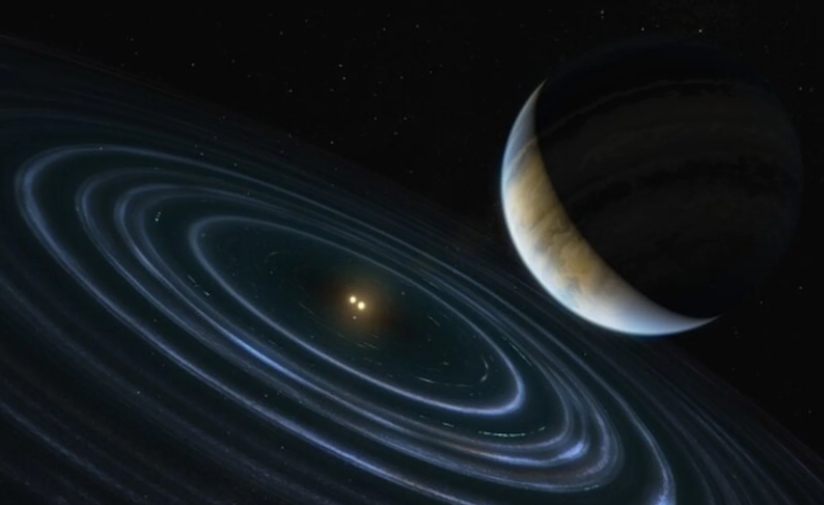Mysterious Planet Nine discovery may be forthcoming after bizarre exoplanet found in deep space

Although scientists have yet to find the elusive Planet 9, a recently discovered exoplanet in deep space may provide further evidence the mysterious celestial object indeed exists.
The exoplanet HD 106906 b is 336 light years from Earth and has a bizarre orbit around its pair of host stars, going around once every 15,000 years, according to a study published in The Astronomical Journal.
First discovered in 2013, the exoplanet is massive, at 11 times the size of Jupiter. Yet, it was only recently, thanks to measurements from the Hubble Space Telescope, that scientists were able to see its elongated — 730 times the distance between the Earth and the sun — and inclined orbit, unlike any of the known planets in the Solar System.
This 11-Jupiter-mass exoplanet called HD106906 b occupies an unlikely orbit around a double star 336 light-years away and it may be offering clues to something that might be much closer to home: a hypothesized distant member of our Solar System dubbed “Planet Nine.” This is the first time that astronomers have been able to measure the motion of a massive Jupiter-like planet that is orbiting very far away from its host stars and visible debris disc.
“To highlight why this is weird, we can just look at our own Solar System and see that all of the planets lie roughly in the same plane,” explained the study’s lead author, Meiji Nguyen of the University of California, Berkeley, in a statement. “It would be bizarre if, say, Jupiter just happened to be inclined 30 degrees relative to the plane that every other planet orbits in. This raises all sorts of questions about how HD 106906 b ended up so far out on such an inclined orbit.”
The researchers believe that HD 106906 b may have formed quite close to its host stars, but over time, drag caused the orbit to decay. Instead of crashing into the stars as would normally happen, the gravity of the two stars pushed it out of the system, but at the right moment, another star passed close by, resulting in a far off, elongated orbit.
If Planet 9 exists, a similar scenario may have played out in the early days of our Solar System, with Jupiter’s gravity pushing it toward the edge, only for it to be saved by another, alien star.
“It’s as if we have a time machine for our own Solar System going back 4.6 billion years to see what may have happened when our young Solar System was dynamically active and everything was being jostled around and rearranged,” study co-author Paul Kalas added.
Researchers want to study HD 106906 b further to learn how it formed and where and see if there are additional links to Planet 9, a celestial object which despite the hype surrounding it, has yet to be found.
“Despite the lack of detection of Planet Nine to date, the orbit of the planet can be inferred based on its effect on the various objects in the outer Solar System,” study co-author Robert De Rosa added. “This suggests that if a planet was indeed responsible for what we observe in the orbits of trans-Neptunian objects it should have an eccentric orbit inclined relative to the plane of the Solar System. This prediction of the orbit of Planet Nine is similar to what we are seeing with HD 106906b.”
A hypothetical planet that has been described as “the solar system’s missing link,” Planet 9 (also known as Planet X) has been part of the lexicon for several years, first mentioned in 2014. It was brought up again in 2016, when Caltech astrophysicists Mike Brown and Konstantin Batygin wrote about it.
In October 2017, NASA released a statement saying that Planet 9 might be 20 times further from the Sun than Neptune is, going so far as to say “it is now harder to imagine our solar system without a Planet 9 than with one.”
Some researchers have suggested the mysterious planet may be hiding behind Neptune and it may take up to 1,000 years before it’s actually found.
Two studies published in March 2019 offered support of its existence, however, a separate study published in September 2019 suggested the theoretical object may not be a giant planet hiding behind Neptune — but rather a primordial black hole.
A study published in January 2019 suggested that some of the farthest celestial bodies in our planetary system aren’t being impacted by this yet-to-be-discovered planet, but rather another mysterious object deep in the echoes of space.



 Creators of mankind
Creators of mankind Description of “Tall white aliens”
Description of “Tall white aliens” Where they came from?
Where they came from? About hostile civilizations
About hostile civilizations The war for the Earth
The war for the Earth “Tall white aliens” about eternal life
“Tall white aliens” about eternal life Video: “Nordic aliens”
Video: “Nordic aliens” Aliens
Aliens Alien encounters
Alien encounters The aliens base
The aliens base UFO
UFO Technology UFO
Technology UFO Underground civilization
Underground civilization Ancient alien artifacts
Ancient alien artifacts Military and UFO
Military and UFO Mysteries and hypotheses
Mysteries and hypotheses Scientific facts
Scientific facts


















